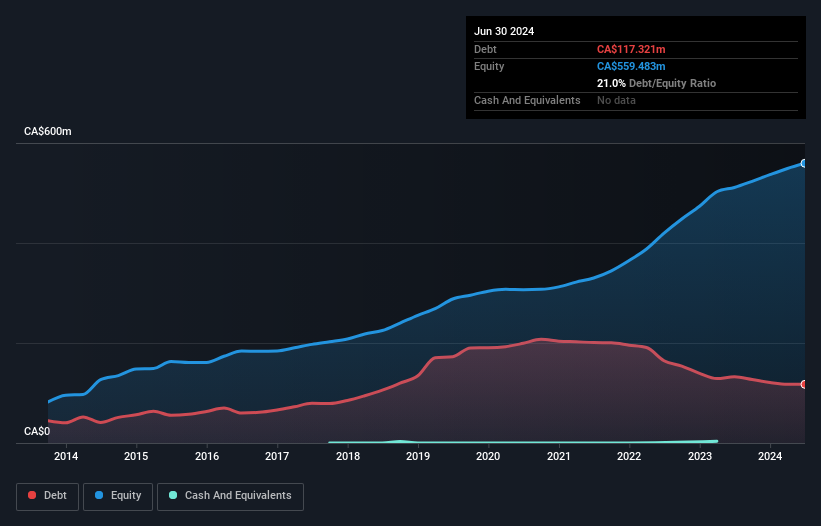David Iben put it well when he said, 'Volatility is not a risk we care about. What we care about is avoiding the permanent loss of capital.' When we think about how risky a company is, we always like to look at its use of debt, since debt overload can lead to ruin. Importantly, Yangarra Resources Ltd. (TSE:YGR) does carry debt. But the real question is whether this debt is making the company risky.
When Is Debt A Problem?
Debt is a tool to help businesses grow, but if a business is incapable of paying off its lenders, then it exists at their mercy. If things get really bad, the lenders can take control of the business. However, a more frequent (but still costly) occurrence is where a company must issue shares at bargain-basement prices, permanently diluting shareholders, just to shore up its balance sheet. Of course, plenty of companies use debt to fund growth, without any negative consequences. When we think about a company's use of debt, we first look at cash and debt together.
Check out our latest analysis for Yangarra Resources
What Is Yangarra Resources's Debt?
The image below, which you can click on for greater detail, shows that Yangarra Resources had debt of CA$117.3m at the end of June 2024, a reduction from CA$132.4m over a year. However, it does have CA$3.50m in cash offsetting this, leading to net debt of about CA$113.8m.

How Strong Is Yangarra Resources' Balance Sheet?
We can see from the most recent balance sheet that Yangarra Resources had liabilities of CA$19.4m falling due within a year, and liabilities of CA$262.1m due beyond that. Offsetting this, it had CA$3.50m in cash and CA$29.5m in receivables that were due within 12 months. So its liabilities outweigh the sum of its cash and (near-term) receivables by CA$248.5m.
This deficit casts a shadow over the CA$110.6m company, like a colossus towering over mere mortals. So we'd watch its balance sheet closely, without a doubt. After all, Yangarra Resources would likely require a major re-capitalisation if it had to pay its creditors today.
In order to size up a company's debt relative to its earnings, we calculate its net debt divided by its earnings before interest, tax, depreciation, and amortization (EBITDA) and its earnings before interest and tax (EBIT) divided by its interest expense (its interest cover). The advantage of this approach is that we take into account both the absolute quantum of debt (with net debt to EBITDA) and the actual interest expenses associated with that debt (with its interest cover ratio).
Looking at its net debt to EBITDA of 1.2 and interest cover of 5.0 times, it seems to us that Yangarra Resources is probably using debt in a pretty reasonable way. But the interest payments are certainly sufficient to have us thinking about how affordable its debt is. Importantly, Yangarra Resources's EBIT fell a jaw-dropping 45% in the last twelve months. If that decline continues then paying off debt will be harder than selling foie gras at a vegan convention. The balance sheet is clearly the area to focus on when you are analysing debt. But ultimately the future profitability of the business will decide if Yangarra Resources can strengthen its balance sheet over time. So if you're focused on the future you can check out this free report showing analyst profit forecasts.
Finally, a business needs free cash flow to pay off debt; accounting profits just don't cut it. So it's worth checking how much of that EBIT is backed by free cash flow. In the last three years, Yangarra Resources's free cash flow amounted to 29% of its EBIT, less than we'd expect. That's not great, when it comes to paying down debt.
Our View
To be frank both Yangarra Resources's EBIT growth rate and its track record of staying on top of its total liabilities make us rather uncomfortable with its debt levels. But at least it's pretty decent at managing its debt, based on its EBITDA,; that's encouraging. After considering the datapoints discussed, we think Yangarra Resources has too much debt. While some investors love that sort of risky play, it's certainly not our cup of tea. There's no doubt that we learn most about debt from the balance sheet. But ultimately, every company can contain risks that exist outside of the balance sheet. For example - Yangarra Resources has 2 warning signs we think you should be aware of.
Of course, if you're the type of investor who prefers buying stocks without the burden of debt, then don't hesitate to discover our exclusive list of net cash growth stocks, today.
New: Manage All Your Stock Portfolios in One Place
We've created the ultimate portfolio companion for stock investors, and it's free.
• Connect an unlimited number of Portfolios and see your total in one currency
• Be alerted to new Warning Signs or Risks via email or mobile
• Track the Fair Value of your stocks
Have feedback on this article? Concerned about the content? Get in touch with us directly. Alternatively, email editorial-team (at) simplywallst.com.
This article by Simply Wall St is general in nature. We provide commentary based on historical data and analyst forecasts only using an unbiased methodology and our articles are not intended to be financial advice. It does not constitute a recommendation to buy or sell any stock, and does not take account of your objectives, or your financial situation. We aim to bring you long-term focused analysis driven by fundamental data. Note that our analysis may not factor in the latest price-sensitive company announcements or qualitative material. Simply Wall St has no position in any stocks mentioned.
About TSX:YGR
Yangarra Resources
A junior oil and gas company, engages in the exploration, development, and production of natural gas and conventional oil resource properties in Western Canada.
Undervalued with excellent balance sheet.
Market Insights
Community Narratives



